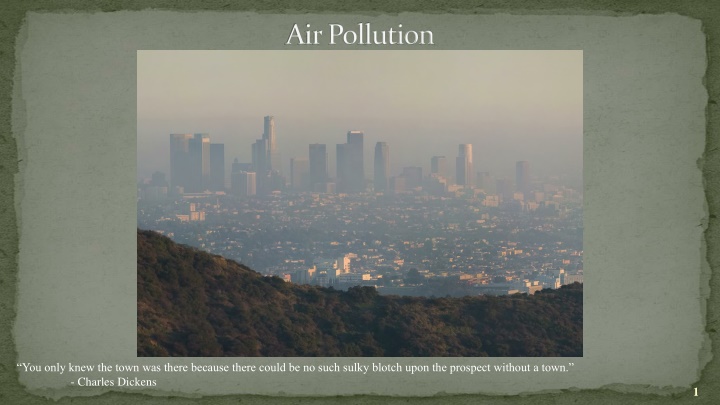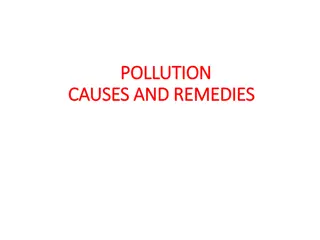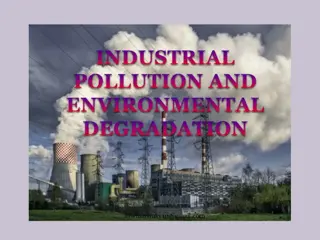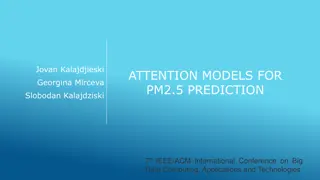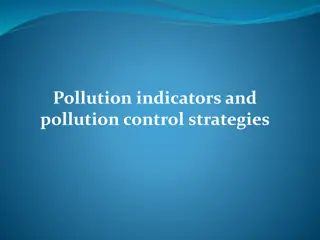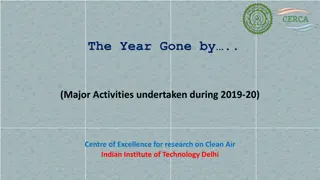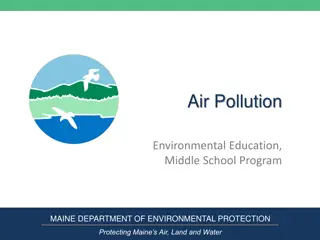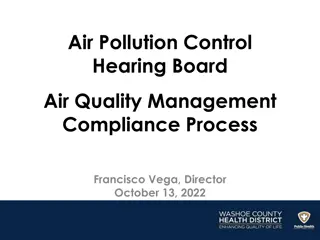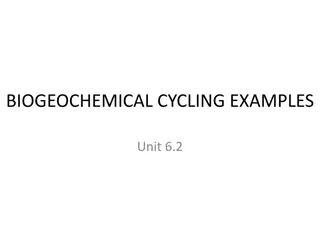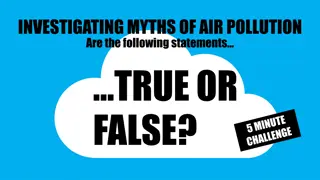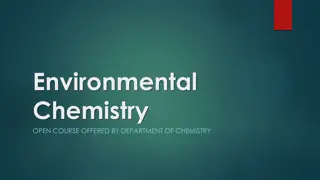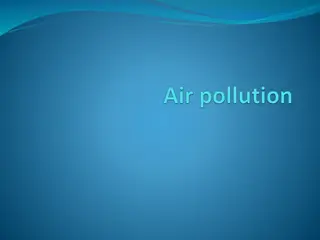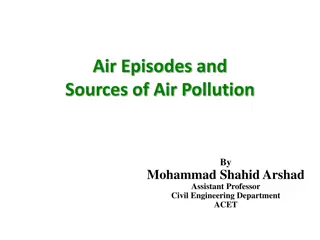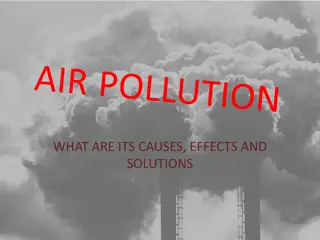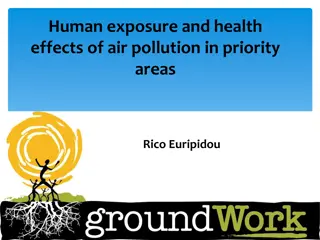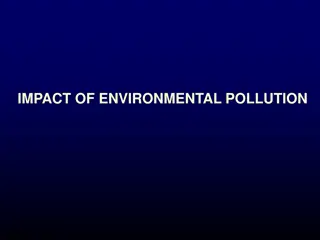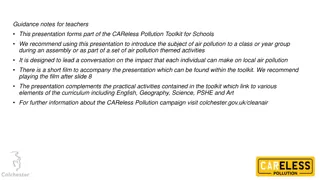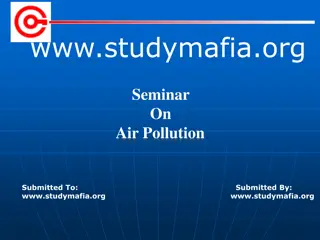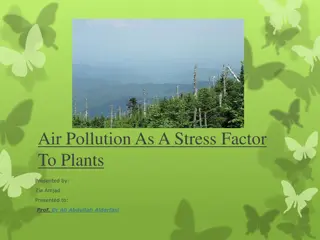Air Pollution and Its Effects
Air pollution is the addition of harmful substances to the air, often resulting from combustion processes like burning fossil fuels. This pollution can have toxic effects on the environment and human health. The Clean Air Act of 1970 was established to regulate and control air pollution levels, aiming to protect the air quality for all. Thermal inversions are natural occurrences where a layer of warm air traps cooler air below, leading to the stagnation of pollution in certain areas. Understanding the causes and effects of air pollution is crucial for environmental protection and public health.
Download Presentation

Please find below an Image/Link to download the presentation.
The content on the website is provided AS IS for your information and personal use only. It may not be sold, licensed, or shared on other websites without obtaining consent from the author.If you encounter any issues during the download, it is possible that the publisher has removed the file from their server.
You are allowed to download the files provided on this website for personal or commercial use, subject to the condition that they are used lawfully. All files are the property of their respective owners.
The content on the website is provided AS IS for your information and personal use only. It may not be sold, licensed, or shared on other websites without obtaining consent from the author.
E N D
Presentation Transcript
Air Pollution You only knew the town was there because there could be no such sulky blotch upon the prospect without a town. - Charles Dickens 1
Air Pollution Air pollution is the addition of any substance that has harmful or toxic effects to air. Most air pollution is the result of combustion; a reaction between a fuel source and oxygen that releases energy. 2
In a chemical reaction, the reactants participate in and change as a result of the chemical reaction. Methane and oxygen The products are the compounds or elements that are formed as a result of the chemical reaction. Carbon dioxide and water. Combustion of a pure fuel, such as natural gas, releases only carbon dioxide and water. 3
Fuels like coal and wood contain non-combustible materials that do not burn, and will either enter the atmosphere as air pollution or be left behind as ash. Coal ash holding pond near Kingston, Tennessee. 4
The Clean Air Act The Clean Air Act of 1970 is a federal law that regulates levels of air pollution produced from all sources: transportation, factories, powerplants, and homes. This law was the result of public outcry following a series of air pollution disasters. Enforced by the Environmental Protection Agency. 5
Thermal Inversion Normally, air becomes cooler as you move higher in the atmosphere. During a thermal inversion, this pattern switches. A pocket of cool air is trapped below a layer of warmer air. Thermal Inversion over New York City, March 10, 2013 by Ken McCown on Flickr. 6
Thermal Inversion Thermal inversions occur most often in areas with little air movement, such as valleys. Warm air is less dense than cool air, so under normal circumstances, pollution will rise into the atmosphere and dissipates. Pollution released into a thermal inversion does not escape. 8
The Donora Fluoride Fog Donora was a company town near Pittsburgh with two metal processing plants: the U.S. Steel Zinc Works and American Steel & Wire. Metal smelting plants like these produce a great deal of pollution, as they burn coal to generate sufficient heat to melt and purify their products. In the days before Halloween in 1948, Donora experienced a 5-day temperature inversion. 9
The plants continued operating through most of the inversion, causing the deaths of 20 people, and sickening thousands. Donora at Noon, Oct 29, 1948 10
The London Smog In 1952, an unusually cold winter struck London. City dwellers were burning high amounts of a low-grade coal that was high in sulfur. A temperature inversion settled over the city, and emissions from thousands of chimneys began to build up. 11
About 4,000 people died during the great smog, with thousands more becoming ill from respiratory tract infections. Central London, December 1952 12
Clean Air Act of 1970 The clean air act required the EPA to set and enforce limits for six criteria pollutants that cause smog, acid rain, and other health hazards. Each criteria pollutant has an abbreviation, usually its chemical formula. Sulfur dioxide (SO2) Carbon monoxide (CO) Particulate Matter (PM2.5 and PM10) Ozone (O3) Nitrogen oxides (NOx) Lead (Pb) 13
Pollutants are classified as primary pollutants if they are released directly into the air. Secondary pollutants form as a result of chemical reactions with the atmosphere. 14
Sulfur Dioxide Sulfur dioxide, SO2, is a colorless gas with a strong rotten eggs odor. The biggest source of sulfur dioxide is coal-burning power plants. Health effects include irritation of the airways and shortness of breath. Sulfur dioxide forms the secondary pollutant sulfuric acid when it comes with water in the atmosphere. This is a major part of acid rain. 15
Nitrogen Oxides Nitrogen oxides, NOx, have a reddish- brown color and a sharp, sweet odor. The largest source of nitrogen oxide pollution is the use of synthetic nitrogen fertilizer in agriculture. Also released as part of automobile exhaust. Exposure to nitrogen oxides increases the risk of respiratory infections. 16
Nitrogen oxides form two secondary pollutants: Nitric acid, which contributes to acid rain. Photochemical smog, a brown haze that forms from a reaction with sunlight. Shanghai People Square, China. Photo by Morgan Nebel. 17
Carbon Monoxide Carbon monoxide (CO) is a colorless, odorless gas. The largest source of carbon monoxide is vehicle exhaust. Carbon monoxide directly interferes with the ability of red blood cells to transport oxygen. Carbon monoxide does not form any secondary pollutants. One of 84 ventilation fans in the Holland Tunnel, New York City. 18
Particulates Particulates are small, visible particles of dust, ash, or soot, and appear the color of smoke. The smell varies depending on what the particles are. Particles less than 2.5 microns in diameter are labeled PM2.5, while articles up to 10 microns in diameter are labeled PM10. Particulates become embedded in lung tissue, reducing oxygen absorption. Particulate matter can also contribute to smog. 19
Lead Lead (Pb) is a heavy metal element. Known to be a neurotoxin that reduces overall brain function. Small particles of lead can attach themselves to particulates, which can then be inhaled. The primary source of lead pollution was automobile exhaust, before leaded gasoline was phased out. 20
Ground-level Ozone Ground-level ozone is a highly-reactive secondary pollutant that damages the living tissues of organisms. Ground-level ozone is produced from a reaction between volatile organic compounds, nitrogen oxides, and sunlight react in stagnant air. Volatile organic compounds are released by the evaporation of fuels, solvents, and paints. Ozone action days are alerts issued when conditions are right for accumulation of the pollutant warm, sunny, windless days. 21
Passage of the Clean Air Act of 1970 had measurable impacts on air quality and health. Some ice core samples show that sulfur emissions, which increased steadily following the industrial revolution, stabilized in the 1970s. Studies have shown 4-8 months have been added to the average American s life span. 22
Clean Air Act 1990 Amendments The Clean Air Act was amended in 1990, adding additional standards to address three major issues with air quality: Acid Rain The Ozone Layer Urban air quality 23
Acid Precipitation Acid precipitation occurs whenever rainfall or snowfall contains a lower than normal pH due to the formation of two secondary pollutants: Sulfuric acid, a secondary pollutant of sulfur dioxide. Nitric acid, a secondary pollutant of nitrogen oxides. Normal rainwater has a pH of about 5.6 due to the presence of carbonic acid. Acid rain has a pH of 4.0 or less. 24
Acid rain has many ecological effects: Many plants cannot absorb nutrients properly from acidic soil. Fish and amphibians have specific pH ranges they can tolerate. Acid rain also has corrosive effects on statues and road structures. A gargoyle severely eroded by acid rain. 25
Acid rain has decreased significantly as greater controls have been placed on emitters of sulfur dioxide and nitrogen oxides. 26
Ozone Layer The ozone layer is an ozone-rich area of the stratosphere that blocks some of the mutagenic ultraviolet radiation from the sun. In the 1970s, depletion of ozone above Antarctica was creating a hole in this protective layer. The hole was growing the fastest during September and October each year. 27
The cause of the hole was discovered to be chlorofluorocarbons (CFCs), compounds that were used in aerosol cans and as refrigerants. The CFCs were becoming trapped in the Antarctic snow and ice, which would then melt in the spring months of September and October. An international agreement, called the Montreal Protocol, was passed in 1987 that phased out chlorine- containing products. 28
CFC release stabilized and has started to decline as a result of the Montreal Protocol. The ozone hole is predicted to heal sometime around the year 2050. 29
Urban Air Quality A massive increase in automobile emissions in urban areas created serious air pollution problems through the 1980s. The following changes were made to reduce this problem: Higher standards on vehicle emissions. Reduction in sulfur content of diesel fuel. Cities with the worst ozone problems were required to use reformulated gas, which as a higher ethanol content. 30
Keeping Air Clean Scrubber systems use a liquid spray to wash unwanted pollutants from a gas stream. Electrostatic precipitators are electrically-charged plates that will attract pollutants, preventing them from being released into the air. 31
Catalytic converters are devices in cars that reduce emissions of pollutants like nitrogen oxides and carbon monoxide by partially converting them to less harmful gases. 32
Cleaner Fuels Switching from fuels that are heavily polluting, like coal, to ones that are cleaner-burning, like natural gas, can also reduce pollution. 33
